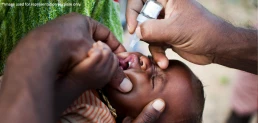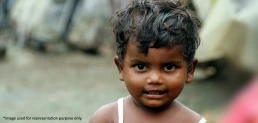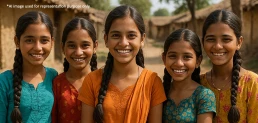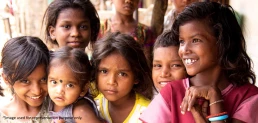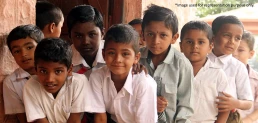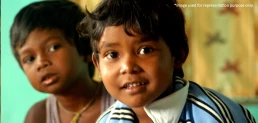Girls in India face deep-rooted social barriers to education—early marriage, safety concerns, poverty, and cultural bias. Despite progress, the literacy rate for girls hovers around 70.3%, exposing gaps in access and retention, especially in rural areas. Educating girls in rural India remains critical not just for gender equality but for long-term national development.
The State of Girls’ Education in Rural India
Rural India shows progress in girls’ school enrolment, especially at the primary level. However, high dropout rates persist beyond elementary education, and girls face barriers in transitioning to higher levels.
Despite strong primary-level Net Enrolment Ratios, retention weakens significantly at secondary and higher secondary stages. Gender gaps also remain a concern across regions.
Also Read: Suggestions to Overcome Gender Stereotypes in India
Why Educating Girls in Rural India Remains a Challenge
The Net Enrolment Ratio for girls drops from 90% in primary to 48% in secondary and 35% in higher secondary levels. This signals major transition issues. Economic pressure, limited access, and cultural expectations disrupt continuity. The slight female advantage at all levels masks deeper challenges of retention.
Many districts lack support mechanisms to guide girls beyond elementary education. Without targeted programs for transitions, vocational options, and quality improvement, rural girls will continue to exit formal education early.
A Snapshot of Enrollment, Dropout, and Literacy Rates
From 2012 to 2022, girls’ enrolment share dropped at the primary level but increased at secondary and higher levels. The NER shows a 42-point drop between primary (90%) and higher secondary (48%) levels.
Although enrolment has risen, dropout rates remain high. Rural girls face sharp falloffs after elementary education, reflecting economic barriers, insufficient infrastructure, and limited female role models.
Also read:- Importance & Advantages of Girl Child Education
Common Social Barriers to Girl Education
Social barriers remain a significant challenge for girls’ education in India. Gender stereotypes, early marriage, safety concerns, and poor school infrastructure limit girls’ access to learning. These deep-rooted societal norms, especially in rural areas, prevent many girls from continuing their education and reaching their full potential.
Gender Bias and Traditional Roles
In many rural communities, traditional gender roles prioritize girls for domestic duties over education. This deeply ingrained bias sees girls’ education as less important than boys’. Societal expectations confine them to household chores.
Overcoming this requires challenging cultural norms through awareness campaigns and community discussions, illustrating the transformative power of education for girls and their communities.
Early Marriage and Safety Concerns
In certain vulnerable communities, early marriage remains a cultural norm that significantly hinders girls’ education. Marrying at a young age shortens their academic journey and creates long-term socio-economic disadvantages. This practice also raises safety concerns.
Addressing this requires community sensitization programs, working with leaders to delay marriages and promote education. Creating safe, supportive environments can help protect girls from these pressures while encouraging continued learning.
Lack of Sanitation and Infrastructure in Schools
Girls in rural areas face difficulty accessing education due to inadequate school infrastructure, particularly sanitation facilities. The absence of clean and private toilets can force girls to miss school during menstruation.
Additionally, overcrowded classrooms and poor teaching resources limit learning outcomes. Improving school infrastructure, providing sanitary products, and ensuring safe, hygienic facilities are critical to ensuring girls attend school regularly.
Also Read: Women Empowerment Through Education
Girls’ Education Challenges: Understanding the Root Causes
Social barriers, lack of school access, poverty, early marriage, and safety concerns limit girls education. Rural areas face higher dropout rates, with only 1% of girls reaching class 12.
Economic Hardship and Prioritization of Boys’ Education
Poverty forces families to prioritize immediate survival over long-term education. In low-income households, boys often receive preference for schooling due to perceived future earning potential. Girls are seen as economic burdens, leading to early dropout.
The cost of uniforms, books, and transport adds to the financial strain. Rural families expect girls to help with domestic chores or income-generating work. As a result, many eligible girls remain out of school despite free education under the Right to Education Act.
Influence of Cultural Norms and Community Pressure
Traditional norms and gender stereotypes reinforce the idea that girls belong at home. Early marriage, pressure to uphold family honor, and expectations of domestic roles reduce girls’ school attendance. Community elders often discourage girls’ mobility, fearing social backlash.
Education is seen as unnecessary for girls who will marry early. These beliefs are deeply embedded in rural communities, limiting long-term efforts to keep girls in school.
Limited Access to Female Teachers and Role Models
In rural India, many schools, especially in remote areas, lack female teachers. Parents hesitate to send daughters to male-dominated schools due to safety concerns. Girls feel more comfortable and supported when female teachers are present.
Programs like Shiksha Karmi train local women to teach, improving attendance. The lack of women in visible leadership also limits aspiration. Without relatable role models, girls struggle to envision academic or professional futures, which affects motivation and long-term educational commitment.
The Positive Impact of Educating Girls in Rural India
Educating girls in rural India leads to significant socio-economic improvements. It empowers them to make informed decisions. This boosts women’s participation in agriculture, local businesses, and health sectors.
Educated women are more likely to invest in their children’s education and health, creating long-term community benefits. It also strengthens gender equality and promotes sustainable development.
Success Stories: Girls Who Overcame the Odds
In rural India, social stigmas often block girls’ paths to education. Yet some stories shine brightly against this challenging backdrop, demonstrating how determination can triumph over deeply entrenched barriers.
Disha, from a small Tamil Nadu village, faced the typical obstacles—limited resources, distant schools, and cultural pressure to marry young. After her elder sister abandoned education for marriage after 11th grade, Disha’s family expected her to follow suit. Instead, she dared to dream differently.
CRY’s timely intervention proved transformative. Recognizing her potential, their team convinced her hesitant parents of the value of education. With this crucial support, Disha excelled academically, scoring an impressive 91% in her 12th-grade examinations.
Despite initial setbacks in clearing the NEET, Disha persisted. With CRY’s continued backing, she joined a coaching program and succeeded on her second attempt with a score of 449, securing admission to Erode Government Medical College. Her journey from a marginalized background to a medical student demolished expectations and reshaped possibilities for her entire community.
Solutions to Break the Cycle of Social Stigma
Here are some potential solutions that can help break the cycle of social stigma:
- Community Awareness Programs: Raise awareness on the importance of girls’ education through local campaigns, emphasizing long-term benefits for families and communities.
- Government Schemes: Strengthen financial support like scholarships, conditional cash transfers, and mid-day meal schemes to reduce economic barriers.
- Improved Infrastructure: To address safety concerns, enhance school facilities, especially in rural areas, with separate toilets and safe transportation.
- Engage Religious Leaders: Collaborate with local religious and cultural leaders to challenge harmful traditions like early marriage.
- Female Role Models: Promote female teachers and leaders to inspire girls and counter traditional gender norms in rural India.
How CRY America Supports Girls’ Education in Rural India
CRY America actively supports girls’ education in rural India by addressing key barriers. The organization focuses on community mobilization, teacher training, and improving school infrastructure. It runs gender-sensitive programs to encourage girls’ enrollment and reduce dropout rates.
Through digital learning initiatives, CRY provides remote education so rural girls can access quality resources.
Also Read: Protecting Marginalized Girls
FAQs
How does educating girls benefit the entire community?
Educating girls leads to higher economic productivity, improved health outcomes, and better societal stability. Educated women are more likely to invest in their families’ well-being. It leads to a positive cycle of empowerment, reduced poverty, and enhanced community development, thus benefiting society.
What are some successful interventions to promote girls’ education?
Successful interventions include providing scholarships, building gender-sensitive schools, and promoting awareness campaigns. Government programs like midday meals and conditional cash transfers also incentivize education. Community involvement, especially through local leaders, ensures the removal of cultural barriers while improving infrastructure to address safety and accessibility issues in rural areas.
How does CRY America contribute to educating girls in rural India?
CRY America supports girls’ education by funding grassroots organizations that work towards the improvement of school infrastructure, linking girls to various scholarship programs, and empowering communities. They focus on eliminating child labor, early marriage, and other barriers, ensuring girls in rural India have equal access to quality education and the opportunity to build a better future.
What can I do to support girls’ education and challenge social stigmas?
You can support girls’ education by donating to organizations, raising awareness about its importance, and volunteering with local initiatives. Challenging social stigmas involves promoting gender equality, educating communities on the benefits of educating girls, and supporting changes that ensure better educational opportunities for girls in rural areas.
Recommended for you











